Related Research Articles

Magnesium is a chemical element; it has symbol Mg and atomic number 12. It is a shiny gray metal having a low density, low melting point and high chemical reactivity. Like the other alkaline earth metals it occurs naturally only in combination with other elements and it almost always has an oxidation state of +2. It reacts readily with air to form a thin passivation coating of magnesium oxide that inhibits further corrosion of the metal. The free metal burns with a brilliant-white light. The metal is obtained mainly by electrolysis of magnesium salts obtained from brine. It is less dense than aluminium and is used primarily as a component in strong and lightweight alloys that contain aluminium.
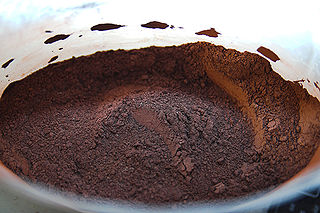
Thermite is a pyrotechnic composition of metal powder and metal oxide. When ignited by heat or chemical reaction, thermite undergoes an exothermic reduction-oxidation (redox) reaction. Most varieties are not explosive, but can create brief bursts of heat and high temperature in a small area. Its form of action is similar to that of other fuel-oxidizer mixtures, such as black powder.

I. G. Farbenindustrie AG, commonly known as IG Farben, was a German chemical and pharmaceutical conglomerate. It was formed in 1925 from a merger of six chemical companies: Agfa, BASF, Bayer, Chemische Fabrik Griesheim-Elektron, Hoechst, and Weiler-ter-Meer. It was seized by the Allies after World War II and split into its constituent companies; parts in East Germany were nationalized.
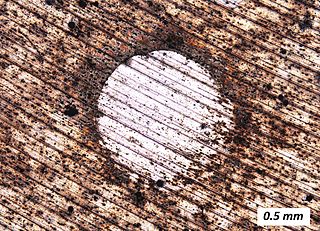
Duralumin is a trade name for one of the earliest types of age-hardenable aluminium–copper alloys. The term is a combination of Dürener and aluminium. Its use as a trade name is obsolete. Today the term mainly refers to aluminium-copper alloys, designated as the 2000 series by the international alloy designation system (IADS), as with 2014 and 2024 alloys used in airframe fabrication.
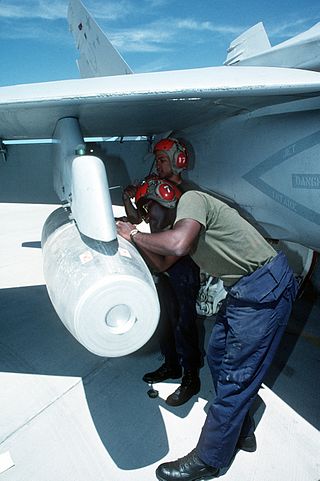
Incendiary weapons, incendiary devices, incendiary munitions, or incendiary bombs are weapons designed to start fires or destroy sensitive equipment using fire, using materials such as napalm, thermite, magnesium powder, chlorine trifluoride, or white phosphorus. Though colloquially often known as bombs, they are not explosives but in fact are designed to slow the process of chemical reactions and use ignition rather than detonation to start or maintain the reaction. Napalm, for example, is petroleum especially thickened with certain chemicals into a 'gel' to slow, but not stop, combustion, releasing energy over a longer time than an explosive device. In the case of napalm, the gel adheres to surfaces and resists suppression.

Norsk Hydro ASA is a Norwegian aluminium and renewable energy company, headquartered in Oslo. It is one of the largest aluminium companies worldwide. It has operations in some 50 countries around the world and is active on all continents. The Norwegian state owns 34.3% of the company through the Ministry of Trade, Industry and Fisheries. A further 6.5% is owned by Folketrygdfond, which administers the Government Pension Fund of Norway. Norsk Hydro employs approximately 35,000 people. Hilde Merete Aasheim has been the CEO since May, 2019.

Hirth Engines GmbH is an engine manufacturer based in Benningen, Germany. It is currently a part of the UMS Aero Group. Hirth began manufacturing aero engines in the 1920s, was taken over by Heinkel in WWII to develop the Heinkel-Hirth jet engines, and today specialises in small two-stroke engines for light aircraft and other applications.

Johannes Wilhelm "Hans" Goldschmidt was a German chemist notable as the discoverer of the Thermite reaction. He was also co-owner of the Chemische Fabrik Th. Goldschmidt, as of 1911 Th. Goldschmidt AG and its most important chemist. The reaction, also called the Goldschmidt process, is used for thermite welding, often used to join railway tracks. Thermites have also been used in metal refining, disabling munitions, and in incendiary weapons. Some thermite-like mixtures are used as pyrotechnic initiators in fireworks.
The American IG Chemical Corporation, or American IG for short, was an American holding company incorporated under the Delaware General Corporation Law in April 1929 and headquartered in New York City. It had stakes in General Aniline Works (GAW), Agfa-Ansco Corporation, and Winthrop Chemical Company, among others, and was engaged in manufacture and sale of pharmaceuticals, photographic products, light weight metals, synthetic gasoline, synthetic rubber, dyes, fertilizers, and insecticides. The Moody's industrial manual listed an affiliation between IG Farben and American IG at the time of founding. First, Hermann Schmitz, who was the second after Carl Bosch in IG Farben's hierarchy, and then his brother, Dietrich A. Schmitz, served as American IG's presidents. It was re-incorporated as General Aniline & Film (GAF) Corp. in 1939 after a merger with General Aniline Works.

An aluminium alloy (UK/IUPAC) or aluminum alloy is an alloy in which aluminium (Al) is the predominant metal. The typical alloying elements are copper, magnesium, manganese, silicon, tin, nickel and zinc. There are two principal classifications, namely casting alloys and wrought alloys, both of which are further subdivided into the categories heat-treatable and non-heat-treatable. About 85% of aluminium is used for wrought products, for example rolled plate, foils and extrusions. Cast aluminium alloys yield cost-effective products due to the low melting point, although they generally have lower tensile strengths than wrought alloys. The most important cast aluminium alloy system is Al–Si, where the high levels of silicon (4–13%) contribute to give good casting characteristics. Aluminium alloys are widely used in engineering structures and components where light weight or corrosion resistance is required.

The IG Farben Building – also known as the Poelzig Building and the Abrams Building, formerly informally called The Pentagon of Europe – is a building complex in Frankfurt, Germany, which currently serves as the main structure of the Westend Campus of the University of Frankfurt. Construction began in 1928 and was complete in 1930 as the corporate headquarters of the IG Farben conglomerate, then the world's largest chemical company and the world's fourth-largest company overall.

The Hirth HM 504 is a four-cylinder air-cooled inverted inline engine. The HM 504 was a popular engine for light aircraft of the 1930s-1940s, and it was used to power a number of Germany's trainer aircraft of World War II. The engine featured a cast magnesium alloy crankcase made of Elektron The Hitachi Hatsukaze Model 11 was a Japanese licensed version.
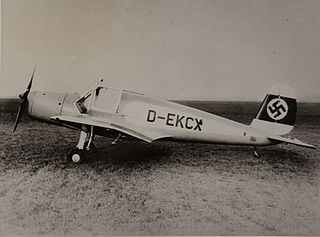
The Arado Ar 79 was an aerobatic two-seat trainer and touring aircraft designed and produced by the German aircraft manufacturer Arado. It was the final civilian aircraft developed by the company.

Mahle GmbH is a German automotive parts manufacturer based in Stuttgart, Germany. It is one of the largest automotive suppliers worldwide. As a manufacturer of components and systems for the combustion engine and its periphery, the company is one of the three largest systems suppliers worldwide for engine systems, filtration, electrics, mechatronics, and thermal management. In 2018, Mahle's sales amounted to over €12.5 billion.
Magnesium Elektron Ltd is a British materials manufacturer which produces magnesium and zirconium metals and compounds. Since 2018 it has traded as Luxfer MEL Technologies, following a series of mergers and acquisitions. It is still based in Manchester.
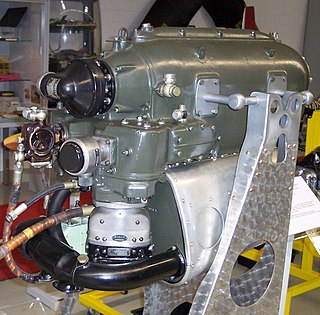
The Hirth HM 500 was a German four-cylinder air-cooled inverted inline engine developed from the Hirth HM 504 in 1938. Although developing the same output of the HM 504 (105 hp) and keeping the same capacity and bore, the HM 500 was a very different engine; the new HM 500 had a one-piece "closed" crankcase for simplified manufacture. The new cooling system reduced cylinder temperatures considerably, and the fuel consumption was also reduced. The HM 500 carried a twin-magneto instead of the two separate magnetos as on the old HM 504. All these changes made that the HM 500 resulted a 12% lighter than the HM 504 and the front surface 37% less than the previous HM 504.
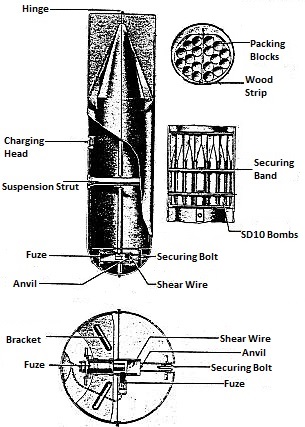
The AB 500-1(Abwurfbehälter) was a cluster bomb used by the Luftwaffe during World War II.

The Fiat A.82 was an air cooled radial engine with 18 cylinders developed by the Italian engineering company Fiat and produced in small numbers during World War II. It was one of the most powerful aircraft engines produced in Italy and the culmination of series of successively larger engines developed from the A.74. It was used as the power plant for one operational aircraft, the Fiat BR.20bis bomber.
References
- ↑ Woldman, Norman E. (2000). John P. Frick (ed.). Woldman's Engineering Alloys. Materials data series. ASM International. pp. 394–396. ISBN 9780871706911.
- ↑ "Glossary E". Aeroplane Monthly. Archived from the original on 12 February 2011. Retrieved 4 October 2010.
- ↑ McNeil, Ian (1990). An Encyclopaedia of the History of Technology. Routledge Companion Encyclopedias. Taylor & Francis. pp. 114–7. ISBN 9780415013062.
- ↑ Aichele, G. (September 2007). "Deutsche Magnesium-Produktion in der ersten Hälfte des 20. Jahrhundert" (PDF). International Aluminium Journal (in German). 83: 84–7. Archived from the original (PDF) on 22 February 2014. Retrieved 11 October 2013.
- ↑ Friedrich, Horst E.; Mordike, Barry L. (2006). Magnesium Technology: Metallurgy, Design Data, Applications. Springer. pp. 4–5. ISBN 9783540308126.
- ↑ von Lüneberg, Hans (2003). Geschichte der Luftfahrt, Volume 1: Geschichte, Flugzeuge (in German). Reinhard Welz Vermittler Verlag e.K. ISBN 9783937081625.
- ↑ "Advertisements: Industry" (PDF). Flight: 17. 27 June 1935. Archived from the original (PDF) on 10 June 2015. Retrieved 1 January 2023.
- ↑ "Company history". MEL Chemicals. Archived from the original on 16 October 2012. Retrieved 25 January 2013.
- ↑ Wagner, Dieter (May 2006). "Chemische Fabrik Griesheim – Pioneer of Electrochemistry". Journal of Business Chemistry. Archived from the original on 22 February 2014. Retrieved 11 October 2013.
- ↑ Ludendorff, Erich (1919). Mein Kriegserinnerungen 1914–1918 (My War Memoirs 1914–1918) (in German). Berlin: Ernst Siegfried Mittler und Sohn. p. 565. "Because of the gravity of our position, the Supreme Command could not hope that air-raids on London and Paris would make the enemy more disposed to sue for peace. Permission was therefore refused for the use of a particularly effective incendiary bomb, expressly designed for attacks on the two capitals, which had been produced in great quantities during the month of August (1918) and which was to have been used in the air-bombardment of the two capitals. The considerable destruction which would have ensued would no longer be enough to influence the course of the war; one could not tolerate carrying out such destruction for its own sake."
- ↑ The Mail (Adelaide), 21 December 1918, p. 1.
- ↑ Hanson, Neil. First Blitz, Doubleday, London, 2008. p. 314 (Chapter 17).
- ↑ Holman, Brett (23 October 2007). "A not very possible fact". Airminded – Air power and British Society 1908–1941. Retrieved 18 July 2019.
- ↑ Brown, Robert E. (17 May 2018). "Review of magnesium for the 75th anniversary of the IMA" (PDF). pp. 4–5. Retrieved 5 July 2021.
- ↑ "Werkstoff-Volumenanteile der 'AR' 79" [Materials proportions by volume of the AR 79 (advertising back matter) ]. Flugsport (in German). Frankfurt/Main. 31 (8): 229 [pdf 32]. 12 April 1939.
- ↑ Jentz, Thomas L.; Doyle, H. L. (1997b). Germany's Tiger Tanks: VK 45.02 to Tiger II - Design, Production and Modifications. Atglen, PA: Schiffer Publishing. p. 64. ISBN 9780764302244.
- ↑ Dorenberg, F. (2010) Feld-Hellschreiber Components. Accessed 10 October 2013.
- ↑ Pearce, William (June 2021). "Planet Satellite Light Aircraft". Old Machine Press. Retrieved 1 January 2023.
- ↑ Spurring, Quentin (2011). Le Mans 1949-59. Sherborne, Dorset: Evro Publishing ISBN 9781844255375, p. 217.